The Ferry System Connecting the Islands
The ferry system is a vital element in bridging the distances between islands, offering an indispensable mode of transportation that facilitates the daily activities of both island residents and visitors. Beyond serving as a basic transit network, it plays a pivotal role in enhancing local economies and supporting the continuity of communal life on the islands through the fluid movement of people, goods, and services. This vast network underpins a variety of essential functions, ranging from enabling trade to promoting tourism, making it an integral component of island existence.
Overview of Ferry Operations
Ferry operations are primarily administered by either governmental bodies or private enterprises. These entities hold the responsibility of crafting schedules and routes that accommodate the diverse needs of island populations. This often involves a diverse fleet of vessels, with sizes and capabilities ranging from modest boats to expansive ships designed to transport vehicles and heavy cargo. Fundamental to these operations is the commitment to regular maintenance and strict safety regulations, practices that ensure the preservation of a reliable and secure means of transportation across the islands’ waters.
Routes and Schedules
The design of ferry routes generally aims to encompass all the significant inhabited islands, with the frequency of service tailored to population density and demand particular to each locale. Consequently, these schedules must remain flexible to accommodate the unpredictable nature of weather, especially in areas exposed to severe meteorological phenomena. Information on the latest schedules and ticket bookings is readily accessible on the ferry company’s official website, ensuring passengers can plan their journeys with the most current updates.
Economic Impact
The ferry system plays a substantial role in stimulating local economies, primarily by fueling tourism and facilitating trade. Tourists benefit from the convenience of accessing multiple islands, which in turn stimulates the hospitality, retail, and leisure sectors. Moreover, the ferry network supports the expansion of local enterprises by providing the necessary logistical support for exporting local goods to broader markets. This connectivity helps small businesses on the islands thrive, underpinning the economic fabric of the region.
Environmental Considerations
Concerns about the environmental impact of ferry systems are prompting many operators to adopt more eco-friendly practices. There’s a growing emphasis on reducing emissions and safeguarding marine ecosystems from damage. Innovations in technology, such as the introduction of electric or hybrid engines, are being investigated by some ferry companies as part of strategies to diminish their ecological footprints. Furthermore, numerous ferry services are actively involved in or supporting environmental projects, including reef restoration efforts that aim to preserve the natural heritage of the islands. Interested parties can learn more about these conservation efforts at the island conservation organization.
Ultimately, the ferry system extends far beyond its function as a transportation linkage; it is embedded into the very fabric of island life, impacting social dynamics, economic growth, and environmental sustainability within the region. Its effective administration is a cornerstone to the ongoing success and resilience of island communities, supporting their vitality and adaptability in an ever-changing world.
Understanding how ferry systems operate involves recognizing the unique challenges and needs associated with island connectivity. Regular coordination among regulatory bodies, ferry operators, and local communities is crucial to aligning the ferry service’s objectives with community needs and environmental priorities. Operators must focus not only on immediate operational issues but also on long-term strategies that promote sustainability and innovation.
Furthermore, collaboration between island communities and ferry companies can foster a cooperative environment for addressing issues such as service affordability, accessibility improvements, and community-focused transport solutions. By establishing partnerships and engaging stakeholders, the ferry system becomes not only a transport mechanism but also a community ally, reinforcing the bonds between different islands.
Delving deeper into the economic implications, the ferry system’s role in tourism cannot be understated. Its involvement in allowing seamless travel between islands is a critical advantage for attracting both domestic and international travelers seeking unique experiences. Furthermore, ferries sometimes offer package deals that include attractions and accommodations, providing economic opportunities that extend well beyond simple travel functions. The ability to promote multi-destination itineraries means that tourists can explore diverse cultural landmarks and natural wonders while contributing substantially to the regional economy.
From an environmental standpoint, the challenge lies in balancing operational demands with sustainable practices. As new technologies emerge, ferry operators face both the opportunity and responsibility to invest in alternative power sources that promise lower emissions and reduced ecological impact. Implementing green practices not only appeals to environmentally conscious passengers but also aligns with global environmental standards and policies.
Moreover, ferry systems that engage in ecological initiatives such as supporting biodiversity in coastal and marine habitats can pave the way for enhanced ecological resilience and the preservation of natural resources. For instance, partnerships with conservation groups to promote scientific research and habitat preservation can boost efforts to protect the marine life and landscapes surrounding the islands.
The broader economic, social, and environmental scope of the ferry system suggests that it must continually adapt and evolve. Innovations in vessel design, route optimization, and customer service technology can lead to improved efficiency and enhanced passenger experiences. Similarly, embracing community feedback and integrating emerging trends into ferry operations help align this transport network with the future needs and expectations of island populations.
In summary, the ferry system remains a crucial connector of islands, deftly interweaving the strands of economic activity, social cohesion, and environmental stewardship. With proactive management and innovation, ferry systems can continue to support the sustainable development of island communities, ensuring they remain vibrant and accessible hubs of human activity and ecological diversity in the years to come.

